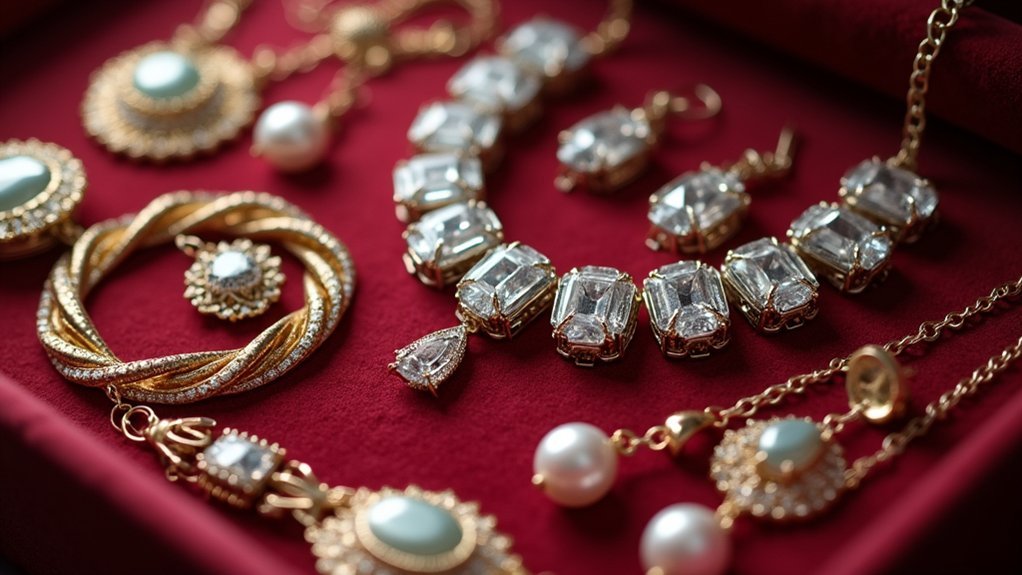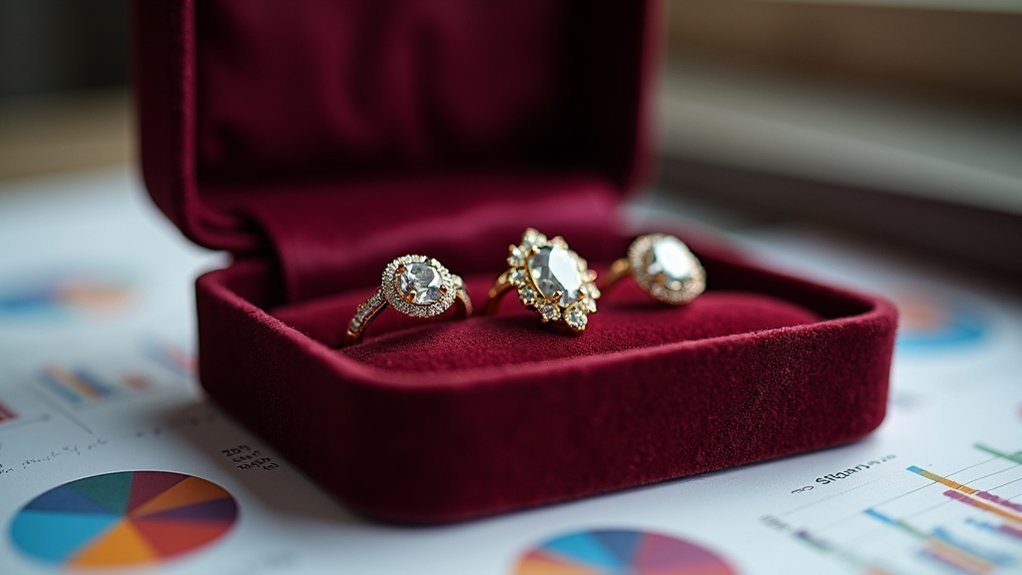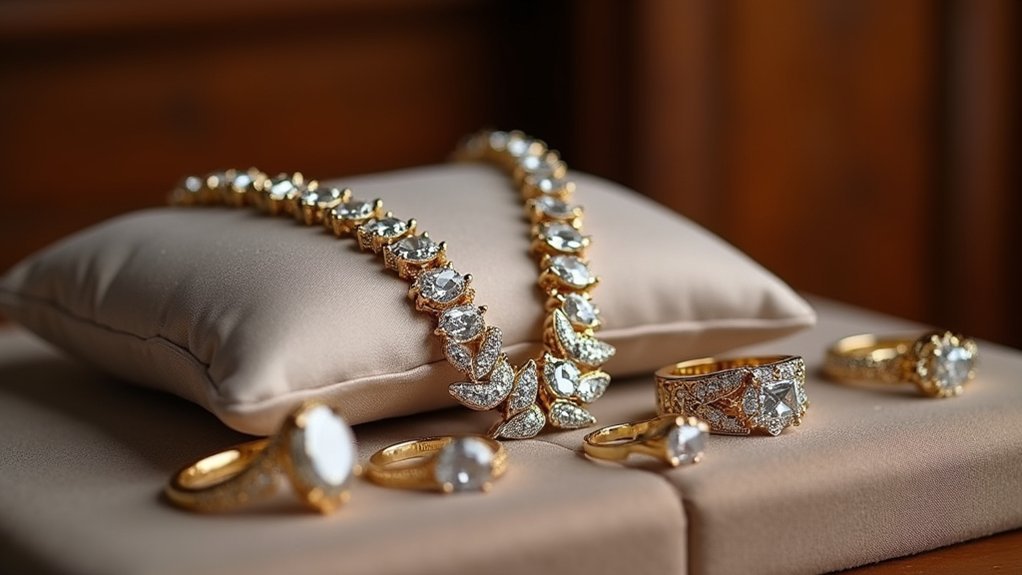Identifying your fine jewelry customer base transforms scattered marketing efforts into laser-focused strategies that deliver real results. You’ll understand whether your customers are brand loyalists seeking established names like Cartier or uniqueness seekers prioritizing distinct craftsmanship for personal expression. This knowledge enables personalized experiences that increase purchase likelihood by 80% and can generate 10-30% revenue increases. When you target luxury seekers, culture enthusiasts, and authenticity lovers with tailored approaches, you’ll discover the proven strategies that turn one-time buyers into lifelong advocates.
Understanding Brand Loyalists vs. Uniqueness Seekers

When you’re identifying your customer base, you’ll discover that fine jewelry buyers typically fall into two distinct categories: brand loyalists and uniqueness seekers.
Brand loyalists gravitate toward established luxury names like Cartier and Tiffany, valuing brand recognition and trust above all else. Their purchasing decisions center on prestigious brand identity rather than individual expression.
Conversely, uniqueness seekers prioritize distinct styles and exceptional craftsmanship. They’re drawn to unique jewelry pieces that allow personal expression rather than brand affiliation.
This demographic appreciates the artistry behind each creation, forming a growing market segment that values individuality over conventional luxury branding.
Understanding these distinctions helps you tailor your approach effectively. While brand loyalists seek prestige, uniqueness seekers want pieces that reflect their personality and values.
Crafting Your Unique Brand Identity and Narrative
You’ll need to establish what your brand fundamentally represents before you can attract the right customers to your fine jewelry business.
Your brand essence should capture the core values, aesthetic vision, and emotional promise that sets you apart from competitors who mass-produce luxury pieces.
Building a compelling heritage story around your craftsmanship traditions, sourcing philosophy, or founding inspiration creates the authentic foundation that uniqueness seekers actively pursue.
Define Brand Essence
The heart of every successful fine jewelry brand lies in its essence—the distinctive story, voice, and personality that sets it apart from countless competitors vying for attention in the luxury market.
You’ll need to establish what makes your unique designs meaningful beyond their aesthetic appeal. Your brand essence should articulate why customers choose you over mainstream luxury options.
Focus on the narrative behind each piece—perhaps emphasizing artisanship, heritage, or innovation. This storytelling creates emotional connections that transform transactions into lasting customer relationships.
Consider incorporating values like ethical sourcing if sustainability resonates with your target audience. Your brand essence becomes the foundation for all marketing decisions, ensuring authentic communication that attracts customers who share your values and appreciate distinctive craftsmanship over mass-market luxury.
Build Heritage Story
Once you’ve established your brand essence, developing a compelling heritage story becomes your next strategic move to create lasting emotional bonds with customers. Your heritage story differentiates your jewelry from mainstream luxury competitors by showcasing artisanship and distinctive qualities that resonate with seekers of uniqueness.
| Heritage Element | Customer Impact | Brand Benefit |
|---|---|---|
| Craftsmanship Origins | Emotional Connection | Authenticity Appeal |
| Design Philosophy | Personal Expression | Value Differentiation |
| Ethical Sourcing | Trust Building | Premium Positioning |
| Artisan Narratives | Pride Association | Loyalty Creation |
Focus on storytelling that highlights personal narratives behind each piece. This approach elevates perceived value while appealing to discerning consumers who prioritize individuality over brand recognition. Customer feedback often reveals that unique designs paired with authentic heritage stories create the strongest purchase motivations.
Defining Your Ideal Customer Profile

You’ll need to map out who your customers really are by examining their demographics and psychographics—from age and income to lifestyle preferences and values.
Understanding what motivates your buyers, whether it’s self-expression, status, or emotional significance, shapes how you’ll position your jewelry.
Your customer’s purchasing patterns reveal when they buy, how much they spend, and what triggers their decisions, giving you the blueprint for targeted marketing strategies.
Demographics and Psychographics
Success in fine jewelry retail starts with knowing exactly who’s buying your pieces and why they’re drawn to them. Demographics reveal the surface-level characteristics of your ideal customer profile—age, gender, income level, and lifestyle factors that shape purchasing power.
You’ll typically find fine jewelry buyers are mainly in their early thirties, married, working full-time, and representing about 16% of the global internet population interested in fashion and jewelry.
However, psychographics dig deeper into what truly drives purchase decisions. These insights uncover your customers’ values, interests, and behaviors—like their preference for sustainable, ethically sourced pieces or their motivation to collect investment-quality jewelry.
Understanding both demographics and psychographics allows you to create targeted marketing strategies that resonate authentically with each customer segment’s unique preferences and motivations.
Values and Motivations
When you dig beneath surface demographics, you’ll discover that successful customer profiling hinges on understanding the core values and motivations driving each purchase decision.
Your fine jewelry customer seeks unique pieces that express individuality and personal style, viewing purchases as extensions of their identity. With 71% prioritizing eco-friendly options, sustainability and ethical sourcing have become decisive factors in their buying journey.
Quality and convenience rank high among motivations, particularly for affluent, modern women who value exceptional service and distinctive products.
Recognize that 82% of buyers want peer respect, positioning your jewelry as social currency rather than mere accessories. These customers aren’t just purchasing items—they’re investing in status symbols that communicate their values, taste, and success to their social circles.
Purchasing Behavior Patterns
Understanding these deep-seated values and motivations provides the foundation for recognizing how your customers actually behave when making purchasing decisions.
When you analyze purchasing behavior among jewelry buyers, you’ll discover that 69% prefer premium versions, indicating your target market values quality over cost savings.
You’ll find 29% of buyers fall into the top income bracket, suggesting they’re willing to invest considerably in fine jewelry.
Additionally, 51% of consumers want to stand out with their appearance, driving demand for unique pieces rather than mainstream options.
Analyzing Existing Customer Data and Patterns

While most jewelry retailers collect customer information during transactions, few systematically analyze this data to discover the valuable patterns hidden within their sales records. Analyzing existing customer data transforms raw transaction information into actionable insights about your target audience.
Your sales records contain demographic goldmines revealing age ranges, gender preferences, and income levels that directly influence purchasing patterns. Here’s what you’ll uncover:
- Seasonal buying trends and preferred jewelry categories
- Customer demographic profiles including age and income brackets
- Psychographic insights from interaction patterns and lifestyle preferences
- Purchase frequency and spending behavior across different segments
- Satisfaction levels and motivations through post-purchase survey responses
Continuously reviewing these patterns guarantees your marketing strategies evolve with changing customer preferences, keeping you competitive in today’s dynamic marketplace.
Creating Targeted Marketing Strategies
Armed with rich customer insights from your data analysis, you can now craft marketing strategies that speak directly to each customer segment’s distinct preferences and behaviors. Targeted marketing becomes incredibly powerful when you understand that 74% of consumers share product information with friends and family.
| Customer Segment | Marketing Channel | Content Focus |
|---|---|---|
| Luxury Seekers | Email campaigns | Craftsmanship stories |
| Culture Enthusiasts | Social media | Diverse experiences |
| Authenticity Lovers | Personal outreach | Individual expression |
Since 81% of jewelry buyers value diverse cultures and experiences, you’ll want to highlight personal stories behind your pieces. This approach builds customer loyalty through emotional connections. Personalized email marketing strategies work exceptionally well for high-end purchases, as jewelry brands that focus on authenticity attract customers seeking uniqueness and individual expression.
Building Emotional Connections Through Storytelling

Beyond demographics and purchasing patterns lies the heart of successful fine jewelry marketing: the stories that transform precious metals and gems into meaningful symbols of life’s most treasured moments.
When you understand your customer base deeply, you can craft storytelling that creates authentic emotional connections. These narratives transform shopping into personal discovery, making customers feel understood and valued.
Your storytelling approach should include:
- Highlighting craftsmanship heritage and artisan techniques
- Connecting pieces to lifestyle themes and personal milestones
- Showcasing creation processes through visual content
- Encouraging customer narratives and user-generated content
- Building community around shared values and experiences
This emotional foundation enables personalized recommendations that feel intuitive rather than pushy.
You’ll foster brand loyalty as customers become advocates, sharing their own stories and amplifying your reach naturally.
Leveraging Social Media Demographics and Platforms
You’ll maximize your fine jewelry marketing impact by understanding which social platforms attract your ideal customers and how they behave on each one.
Instagram’s visual-first format perfectly aligns with the 81% of fashion and jewelry buyers who crave cultural inspiration, while platform-specific demographic data helps you allocate your marketing budget effectively.
Your targeting strategy becomes precise when you match your brand’s unique appeal to the specific user behaviors and preferences found on different social channels.
Platform-Specific Audience Insights
Since each social media platform attracts distinct demographic groups with unique behaviors and preferences, your fine jewelry brand’s success depends on understanding these nuances to craft targeted strategies.
Your jewelry marketing efforts must align with platform-specific audience characteristics to reach potential customers effectively:
- Instagram and Pinterest: 67% of buyers discover new brands through these visual platforms, making them essential for showcasing your jewelry’s aesthetic appeal.
- TikTok and Instagram: Millennials and Gen Z dominate these platforms, presenting opportunities for trend-focused content and influencer collaborations.
- Community engagement: Over 50% of consumers interact with brands on social media, requiring interactive content strategies.
- Ad-blocker awareness: 57% of users block traditional ads, necessitating authentic influencer partnerships.
- Demographic tailoring: Each platform’s unique user base demands customized messaging that resonates with specific values and preferences.
Targeting Through Demographics
Demographics serve as your compass for charting the complex landscape of social media marketing, where each platform’s unique user composition determines your fine jewelry brand’s targeting success.
You’ll find Instagram’s 73% usage rate among 18-29 year-olds makes it perfect for reaching millennial and Gen Z customers who respond to visual trends.
Facebook’s 32% concentration of 30-49 year-olds expands your reach to established buyers with higher purchasing power.
TikTok’s 60% user base aged 16-24 offers innovative jewelry marketing opportunities through trend-driven content.
Developing Personalized Customer Experiences

When customers feel understood and valued through personalized experiences, they’re 80% more likely to make a purchase from your fine jewelry business.
Creating tailored interactions transforms casual browsers into loyal buyers and keeps existing customers returning for luxury jewelry pieces.
Implementing personalization strategies delivers measurable results:
- Customized recommendations – 70% of customers want personalized product suggestions based on their style preferences and occasions
- Targeted email campaigns – Personalized messaging increases open rates by 26% for better customer engagement
- Data-driven shopping experiences – Using purchase history creates bespoke experiences that boost retention by 10-15%
- Individual preference tracking – Understanding buying patterns helps curate relevant luxury jewelry selections
- Revenue optimization – Personalization strategies generate 10-30% average revenue increases across fine jewelry businesses
Understanding Fashion and Jewelry Buyer Motivations
Beyond crafting personalized experiences, you need to understand what drives your customers to purchase fine jewelry in the first place.
Your buyer motivations research reveals that customers primarily view jewelry as symbols of success, power, and personal expression. In today’s jewelry market, 69% of buyers prioritize premium quality and uniqueness over mass-produced alternatives.
Premium jewelry buyers seek symbols of success and personal expression, with 69% choosing quality and uniqueness over mass production.
The emotional experience plays a vital role in purchasing decisions. Your customers don’t just buy jewelry; they invest in feelings of being special and pampered. These purchases boost their self-esteem and reinforce their personal identity.
Additionally, 42% seek community connection through brand engagement.
Modern buyers demand transparency, sustainability, and authenticity from brands they support, making these values essential for building lasting customer relationships.
Implementing Influencer Marketing and Brand Advocacy
How can you leverage the authentic connections that influencers create with their audiences to showcase your fine jewelry brand? Influencer marketing offers a powerful alternative to traditional advertising, especially since 57% of buyers use ad-blockers. You’ll reach engaged audiences who trust their favorite personalities’ recommendations.
Consider these strategic approaches for effective brand advocacy:
- Partner with influencers who align with sustainability values, as 71% of jewelry buyers prioritize eco-friendly options.
- Target celebrity endorsements, since 26% discover new brands through these partnerships.
- Focus on social media collaborations where buyers are 67% more likely to engage.
- Encourage authentic storytelling that triggers word-of-mouth, as 74% share discoveries with friends.
- Select influencers whose aesthetic matches your fine jewelry positioning.
This approach creates genuine connections that translate into lasting customer relationships.
Addressing Sustainability and Eco-Friendly Preferences
Since 71% of fashion and jewelry buyers prioritize eco-friendly options, you can’t afford to ignore sustainability when identifying your target customer base. This massive shift means you must understand which customers value ethical sourcing and recycled materials.
With 57% of consumers willing to pay premium prices for sustainable products, these eco-conscious buyers represent a lucrative market segment.
You’ll need to identify customers who research brand practices and seek transparency in sourcing. These buyers actively look for recycled metals, conflict-free gemstones, and responsible manufacturing processes.
As sustainability becomes mainstream, you risk losing customers without green initiatives. Adapt your customer profiling to include environmental values, then tailor your marketing to emphasize your eco-friendly practices and ethical commitments.
Maximizing Customer Lifetime Value and Retention
Once you’ve identified your fine jewelry customer base, transforming those insights into long-term profitability becomes your primary focus.
Understanding your customers’ demographics and psychographics enables you to develop compelling narratives that foster emotional connections and encourage repeat purchases. When you implement customer lifetime value strategies through personalized experiences, you’ll see significant improvements in retention rates.
Here’s how you can maximize customer lifetime value:
- Create tailored offerings that align with customer preferences and values
- Develop personalized experiences for specific customer segments
- Implement customer feedback mechanisms to refine your strategies
- Foster emotional connections through compelling brand narratives
- Leverage the fact that 74% of satisfied consumers recommend trusted brands
These strategies strengthen relationships and transform one-time buyers into loyal advocates.
Frequently Asked Questions
Who Is the Target Audience for Jewellery Business?
Your target audience includes affluent professionals, special occasion shoppers, and fashion-conscious millennials who value quality and uniqueness. You’ll attract eco-minded consumers, individualists, and collectors seeking authentic, customizable pieces that reflect their values.
How Do You Identify Your Target Customer Base?
You’ll analyze your existing customer data to spot purchasing patterns and preferences. Conduct post-purchase surveys with incentives, then segment customers by demographics and lifestyle factors to create targeted marketing strategies.
Why Do People Buy Fine Jewelry?
You buy fine jewelry to express your personal style, showcase your success and status, enjoy the luxurious shopping experience, boost your self-esteem, and celebrate achievements with beautiful, high-quality pieces.
What Is the Target Demographic for Jewelry?
You’re targeting affluent professionals in their early thirties who’re married, work full-time, and earn high incomes. They’re culturally curious, value peer respect, invest in gold, and seek distinctive pieces reflecting their sophisticated taste and status.
In Summary
You’ll transform your fine jewelry business by identifying your customer base. You’re not just selling products—you’re building relationships with people who value craftsmanship, luxury, or sustainability. When you understand whether they’re seeking brand loyalty or uniqueness, you can craft targeted strategies that resonate. You’ll increase sales, improve retention, and create lasting connections. Don’t guess what your customers want—know them, serve them better, and watch your business flourish in today’s competitive marketplace.





Leave a Reply